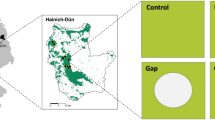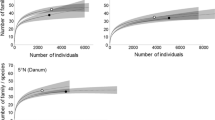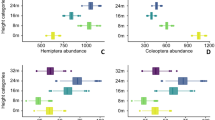Abstract
Tropical forest gaps are ephemeral and patchily distributed within forest areas and have very different light environments compared with closed-canopy forest. We used fruit-baited traps to investigate if gaps are exploited by more opportunistic butterfly species compared with closed-canopy forest. Gaps supported a higher diversity of butterflies in terms of species evenness but closed-canopy sites contained species with more restricted geographical distributions. There was little similarity between the assemblages of butterflies trapped in the canopy and those in either gap or closed-canopy sites, but the greater similarity was with gaps, and increased diversity in gaps was partly due to canopy species turning up in gaps. Dispersal rates (as measured by recapture rates) were higher in gaps and there was evidence that butterflies in gaps had relatively larger and broader thoraxes, indicating a flight morphology adapted for faster flight. These results support the notion of a distinctive gap fauna comprising more widespread, mobile species. Habitat modification that opens up the canopy is likely to result in an increase in these widespread species and a decline in understorey species with restricted distributions.
Similar content being viewed by others
Author information
Authors and Affiliations
Additional information
Electronic Publication
Rights and permissions
About this article
Cite this article
Hill, J., Hamer, K., Tangah, J. et al. Ecology of tropical butterflies in rainforest gaps. Oecologia 128, 294–302 (2001). https://doi.org/10.1007/s004420100651
Received:
Accepted:
Published:
Issue Date:
DOI: https://doi.org/10.1007/s004420100651




